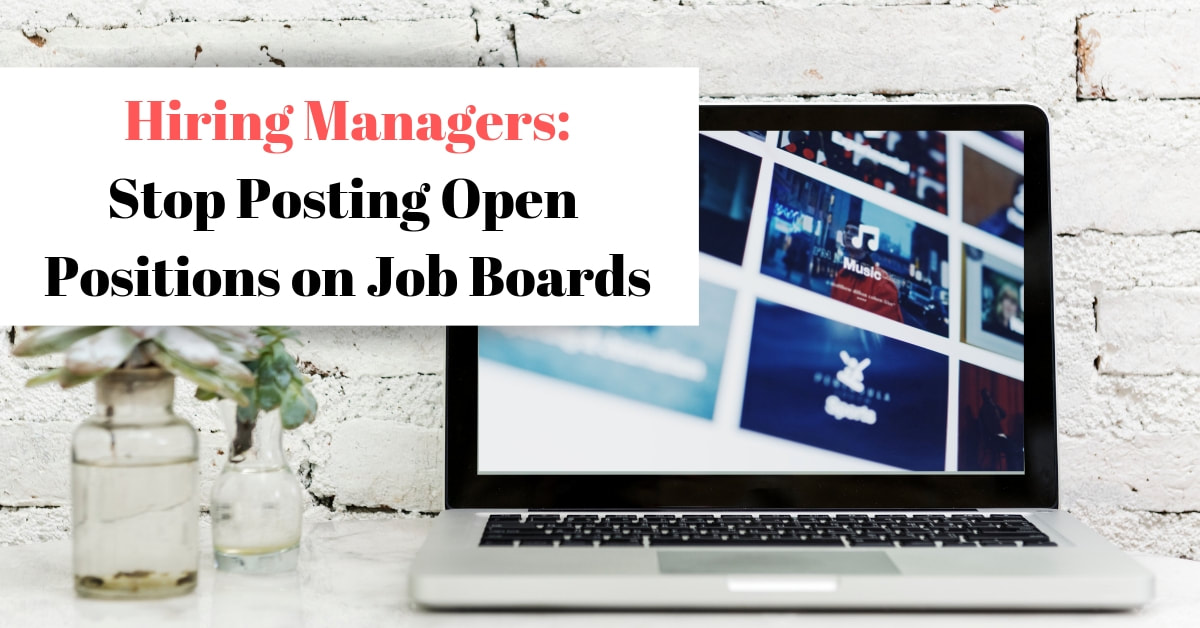|
You walk into work and on your desk you find that one of your best employees has just handed in their two week resignation. It’s upsetting news, but unfortunately every hiring manager will have go through the process of replacing talent. The question is, where do you find this talent? As a recruiting specialist with over 23 years of experience, I can tell you that it’s not via job boards or your corporate careers website. In fact, those are actually one of the worst places to post your open positions because anybody and everybody can apply, qualified or not. Job boards are not everything they are cut out to be for a few reasons. You Don’t Have the Time Let’s be honest. Are you actually going to look through every single resume? The honest answer is no, because you just don’t have the time. The average job posting receives 75-250 resumes. While more resumes may seem like a good thing because you can screen more candidates, it is also a time consuming task that neither you nor HR can devote your time to. Although, many companies have attempted to speed up the process by utilizing programs that scan resumes and send back any that have matching keywords, the truth is the program can never replace a human when it comes to finding great talent. Resumes are a story of growth and experience. Robots aren’t programmed to find potential between the lines, therefore they will miss things that you might find valuable. So either way you are going to lose great talent for one reason: you don’t have time to do it yourself. The Applicants are Cheating on You The resumes you get on job boards are from what we call, professional job searchers. While you’re working, their 9 to 5 consists of applying to job after job. There may be a valid reasons for this, and being temporarily unemployed is not a bad thing. However, you know without a doubt that you are not the only one they are sending their resume to. They are not invested in you and your company, they are instead focused on landing any job that will call them back. As a hiring manager, you should want the candidates that you are recruiting to be invested in you and excited to work for you, not any company out there. Invested candidates become invested employees, and you only deserve employees that are invested in the success of your company. The People You Want Don’t Look at Job Boards You want professionals who have a proven track record of success and who enjoy coming to work. Hate to break it to you, but those professionals already have jobs and they are not going to be looking at your job posts. However, that doesn’t mean they aren’t interested in a new opportunity. If you want passive candidates you are going to have to find them and approach them yourself. This means asking your network, scouring around LinkedIn or candidate boards, or attending networking events. All of which are very time consuming tasks that don’t guarantee that you’re going to find the talent you are hoping to find. Your Resume Database is Outdated When was the last time you collected resumes? It was likely the last time you posted an open position. Therefore, your resume database is going to be out of date. As time goes on people progress in their careers. The marketing director who submitted their resume two years ago isn’t going to want to apply for an open marketing director job now because they are further in their career now. Furthermore, candidates who used to be unqualified have likely completed tasks and projects that would make them qualified now, but you don’t know about it because you don’t have an updated resume. Therefore, if you aren’t regularly updating your resume database the candidates you pull do not exist anymore, and any resume will be old and inapplicable to your current search. You Want an Outside Opinion Hiring from a job board usually follows the standard hiring process of resume, phone interview, in person interview, fly in, and hire. The process is typical among most companies, but it offers hiring managers very little time to really get to know the applicant. As a result, according to LearshipIQ only 19% of all new hires are considered successes by hiring managers, whereas, 46% were considered to be mis-hires. The hiring process does not give hiring managers enough time to evaluate whether a candidate would be successful or not. Therefore, you want another invested party involved in the hiring process so they can get to know the candidate outside of the typical process and give their second opinion. The Solution If not on job boards or the corporate career site where should you find applicants for your open positions? The answer is simple: use a recruiter. Recruiters are devoted to finding you the best talent based on your needs. We not only get to know you and your company, but we become your ambassadors to the passive candidate network. The candidates we send you are unavailable on job boards, and we are able to get to know them on a more personal level than the typical hiring process allows ensuring that they have the skills and qualifications that you need. Furthermore, when we contact qualified passive candidates, as your ambassador, we pitch your company for you, thereby building their interest in your position. Recruiters do what a job board fails at. We provide candidates that resonate with you and your company. While only 19% of employees hired from typical hiring methods are considered a success, DCAProSearch has a 92.8% repeat business rate due to the success of our candidates. Recruiters are invested in their clients and we find talent who are just as invested. The majority of our candidates rise up the ranks to become directors, VPs, and managing partners. Therefore, while job boards find resumes, recruiters find talent that is invested in your company and your success. So stop posting your open positions on job boards and call a recruiter, because you deserve talent that is just as invested as you.
1 Comment
We are in a candidate market, which means one thing: If you are not giving your employees what they want, they will leave you. To make matters more complicated, once your employees leave you, it will be difficult to fill those positions unless you give the new candidates what they want plus more. The most recent jobs report revealed that companies have more open positions than there are qualified employees to fill them. The vacancy of a mid-to-top-tier level employee making $100,000 typically costs a company $1,149 a day, assuming the average employee brings in three times their salary. Therefore, as an employer and team leader you need to take a few steps to ensure your talent remains with you to avoid the costs of an unexpected vacant position.
Team Up with an Outside Recruiter When I connect with new clients, the main excuse they give me is, “Why do we need an outside recruiter? That’s what HR is for.” Except not really”. Your company’s HR has many essential functions they oversee. Recruiting and developing talent is an area they can’t truly devote too much time to and a lot of great talent is missed or neglected. When employees decide they want to pursue another position, it is likely because an outside recruiter contacted them about a great opportunity elsewhere. Therefore, an outside recruiter can either be your biggest competition or your best friend. Job candidates see outside recruiters as an unbiased third party and more trustworthy than your HR contact. As your ally, executive recruiters can train an employee on how to progress within the company rather than find a new position. Furthermore, any ethical recruiter will refuse to siphon talent from an existing client making the executive recruiter your friend as opposed to your competition. Ensure Your Employees are Your Top Priority The expectations of employers usually revolve around two ideals: make a profit for shareholders and keep customers happy. However, employees have begun to demand that they be included in the mix too. Studies have shown that the happier employees are at work the less likely they are to leave, and the more value they bring to the company. Therefore, implement office activities that break the monotony of the work day and keep employees excited about coming to work. For offices on a higher budget that could be taking team development days at a Ropes Course or schedule an office Happy Hour. Offices on a lower budget can sign up for an Ice Cream of the Month Subscription or even go out to volunteer together as a team. Stop Building a Team and Start Forming a Family While team building is important, no amount of team development days can replace the connection that you will build with your employees. The number one reason candidates refuse to leave their current position is because of the bonds they have formed with their managers and colleagues. Make it a point to get to know what your employees do outside of work. Meet their families and connect with their kids on bring your kid to work day. Attend events that your employees invite you to. Form connections with them outside of the daily 9 to 5. The close family bonds that employees form with the people they work with are what keeps them at a company, and in some cases cause them to follow their bosses or colleagues to a new company if they leave. Train Steadily and Promote Regularly Nobody likes to feel stagnant in their job. The majority of employers will hire new talent and expect them to hit the ground running. However, training them too quickly will typically result in one of two things: the employee will feel overwhelmed, shut down, and leave after a year, or the employee will perfect their role, enjoy it, and then feel unchallenged after a year. The key to a new hire is to continue to develop their skills steadily to keep your employees challenged and always learning. Training them steadily as opposed to all at once will allow them to master, and in some cases improve, how they perform each task they are assigned before venturing to the next challenge. Finally, after about two to three years when they have learned everything in their current role, promote them to continue challenging their skills and keep them from feeling stagnant. If you Love Them, Let them Go It’s hard to accept, but sometimes there just is not anything more you can do for your employees and it is out of your control. It may be that they deserve to get promoted but you do not have a position, or they got an offer that is too good to be true. Whatever the case, if you want to see them succeed you have to let them go. Throw them a departure party and invite the rest of the team. This way you can get closure, the rest of your employees can get closer, and the employee leaving can feel valued. Letting your employee leave will give them skills and experiences you could not have taught them, and will make them better. However, do not throw away all hope. If you did everything right, many employees realize how good they had it at their previous company and will come back later when a position opens. Therefore, it isn’t a “goodbye,” but rather a “see you later.” In the meantime call your outside recruiter and start a search to find the next member of your team. Losing an employee is always difficult and costly, but making your employees feel valued is the best way to ensure that you retain your team. Build a connection with them and the other members on your team and express with them that you are glad they joined the team. However, don’t be so naive to believe an employee will never leave you. Be ready for them to depart unexpectedly, because one day they will find an opportunity that is too good to pass up. Find an executive recruiter, and be proactive in recruiting by forming a relationship with your recruiter. That way your recruiter knows what you value in your employees so they can keep some people in mind if the day comes you need to replace an employee. Before the rise of the modern day activist brand, companies previously held a low standard on what it meant to be a socially conscious brand. However, as the evolution of the socially conscious brand has begun to take on more meaning, consumers are demanding brands take a stand on the social inequalities that the brands had once tried to ignore. Marketers must understand the evolution of the socially conscious brand to foresee the future of what the socially conscious brand will become.
1900’s: Fiscal Philanthropist In the past, brands did not have to do much to be considered socially conscious. All they had to do was simply write a yearly check toward a cause or selected charity. Their impact to bring about social change was no more than the silent Fiscal Philanthropist. Although their monetary donations are appreciated, the donations did little to bring positive social change. Today, brands still claim to be socially conscious by writing a yearly check. However, consumers are dismissing the "blank check" approach as part of a corporate show with little sentiment to create lasting social change. Mid 2000’s: Social Givers Then came along brands like Tom's and Warby Parker that revolutionized the Socially Conscious Brand with the Buy One, Give One model of giving that redefined what it meant to not only be socially conscious, but active. The new socially conscious brand was no longer a once-a-year commitment, but a constant source of social good to support far-away nations and impoverished peoples. This created a wave of corporations poorly copying the Tom's and Warby Parker model of the socially conscious brand, pushing to remain relevant by engaging in a form of corporate poverty porn. Major companies patted themselves on the back by appearing in photos and videos as saviors of the third world, but continuing to remain silent to the inequalities that existed at home. 2010 – 2016: Cautious Ally With the rise of multiculturalism and the modern LGBT movement, 2010 brands began to test their influence to impact social change. As support for diversity and LGBT causes increased, brands such as IKEA, Oreo, and Tiffany & Company recognized the power of representation by engaging with the LGBT movement. The introduction of same-sex couples to their advertisements not only brought higher sales and brand recognition, it created discourse about the subject. This recognition brought about the need for increased diversity and multiculturalism in advertising to represent all consumers. Companies followed suit, releasing campaigns like Coca Cola’s America the Beautiful ad in 2014 that championed racial and ethnic diversity. The new Socially Conscious brand was a champion for diversity and used its influence to recognize the beauty of multiculturalism. Consumers rewarded brands that they saw represented the diversity of America with higher sales and higher brand recognition. Hundreds of companies began establishing diversity and inclusion departments to mirror the diversity of the marketplace in their offices to encourage diversity of thought. However, although brands were quick to embrace multiculturalism and include those once ignored by advertisers, their involvement only went as far as being cautious corporate allies. Brands were still skittish around causing real social change. 2016 - Present: Vocal Activist The election of the new administration rang in a new era for the Socially Conscious Brand: The era of the Resistors. Socially Conscious Brands have evolved from the brand as an active observer to a vocal advocate against injustice. The presence of more multicultural, female, and LGBT representation in the workforce has given rise to the vocally polarizing brands we see today. From Ben & Jerry refusing to serve two scoops of the same ice cream in Australia for LGBT rights to Nike’s Collin Kaepernick ad to the recent Gillette #MeToo ad, brands have recognized the power of their voice for social change. Today, the socially conscious brand must go further than donate money. They must create discourses around injustice and be able to challenge the status quo. Consumers are more active in social issues than ever, and they expect the brands they use to reflect those values. Although new social warrior brands have repelled some consumers, all in all, they have been rewarded for their social convictions by loyalists and activists alike. 2020 – Future: Transparent Role Model Skepticism still exists around the socially conscious brand of today and the motives behind becoming social warriors. Many consumers argue that the socially conscious brand is only challenging the status quo to benefit their bottom line. Therefore, the socially conscious brand of the future must prove to consumers that they practice what they preach by incorporating diversity throughout the office. Transparency is the next step in brand evolution where consumers will want to see top management reflecting diversity principles that the company promotes. Customers in stores will want to see products that accommodate people of different abilities, religions, and gender identities. Marketers, heed note because soon enough diversity will become tangible in the products and services we use every day. Utilize diversity recruiters to start the change in the office space, create social groups within your company to celebrate diversity, and engage in social celebrations such as Pride and other cultural festivals. Start preparing your corporate culture now because otherwise, you will fail to be the socially conscious brand of tomorrow. |
AuthorDCAProSearch Archives
April 2020
Categories
All
|
Knowledge is power
Service FORMS |
Company |
|




 RSS Feed
RSS Feed